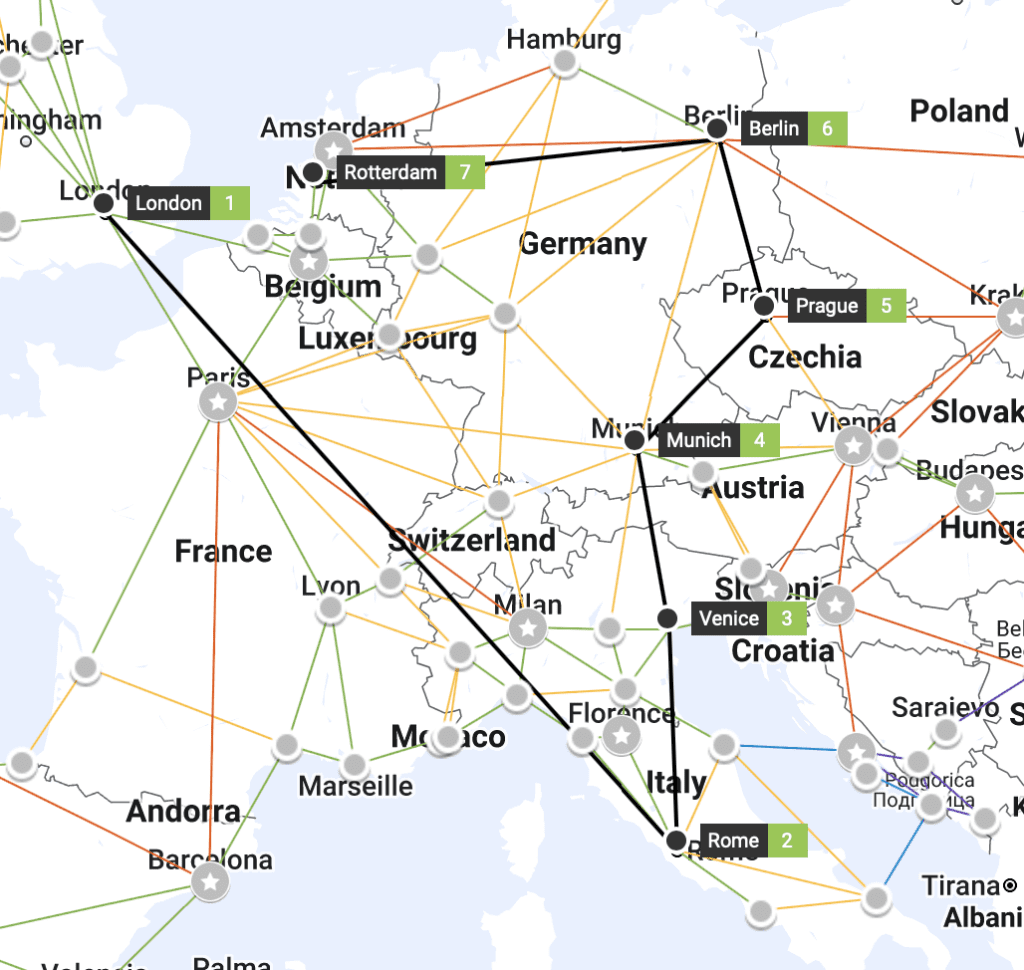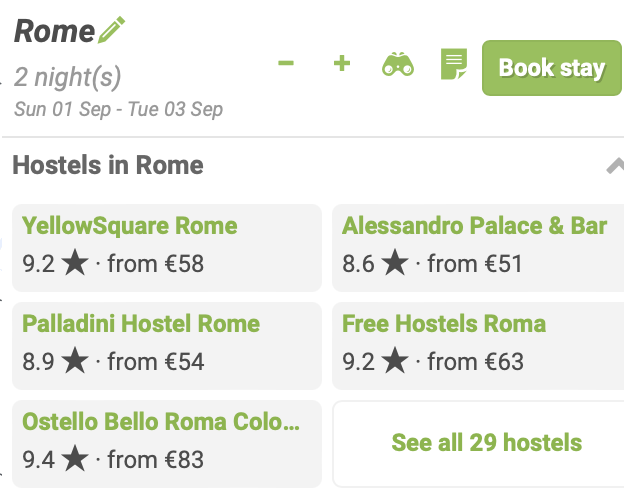An Interrail trip is an exciting adventure that allows travellers to explore multiple European countries affordably and efficiently by train. Whether you’re a seasoned traveller or a first-timer, planning an Interrail trip can seem daunting.
This guide will cover all you need to know, from understanding what an Interrail pass is to choosing the right one, planning your route, and packing the essentials.
- What is an Interrail Pass?
- Choosing a Route
- Choosing an Interrail Pass
- How to Use an Interrail Pass
- What to Pack
- Where to Stay
- What to Do
Let’s dive in.
What is an Interrail Pass?
An Interrail Pass is a train ticket that allows European citizens and residents to travel between 33 European countries. It provides access to 35 railway and ferry companies, encompassing almost all trains in the continent.
Interrail Passes are customisable to fit any journey and flexible to accommodate any last-minute itinerary changes. It’s an excellent way to explore Europe on your own terms!
Choosing a Route
The first step of how to plan an Interrail trip is choosing a route. The Interrail Planner tool is essential; it offers a simple way to organise your schedule among the hundreds of possible route options.

The tool allows you to pick your starting point, then build a trip however you’d like. You can customise journey durations, track your Interrail Pass days, calculate your budget, view accommodation options, and more. Some of these features are available to Premium users only.
When you add destinations, they appear on the map, making it simple to visualise your trip:

The tool also automatically gives you options to book stays, letting you see each choice’s star rating out of ten and how much it costs:

In addition to these features, you can calculate the entire cost of your trip, buy and add passes, and save trips to revisit them in the future. With the Interrail Planner tool, you can quickly and easily organise your entire trip, from rail tickets to accommodations and everything in between.
Popular Routes
There are many popular routes that interrailers enjoy:
The Whole Hog
The Whole Hog is a customisable 2-4 week adventure that starts and ends in London. It features some of the most popular European destinations.
The 2-week trip includes London → Amsterdam → Berlin → Prague → Vienna → Rome → Venice → Paris → London.
3 weeks adds Budapest, Zagreb, Florence, Rome, and Milan. 4 weeks gives you a little more time to explore each destination and adds Bratislava.
Group Tours
You can also book 1-4 week group tours that are led by experienced guides. Popular options include:
- Berlin to Budapest: Berlin → Prague → Vienna → Budapest
- Western Europe: Venice → Rome → Florence → Nice → Barcelona → Paris → London
- Central Europe: London → Amsterdam → Berlin → Prague → Budapest → Vienna → Venice
Group tours are a wonderful way to meet other European travellers and explore the best of what each city has to offer without worrying about planning your own itinerary.
Country Guides
Looking for some Interrail inspiration?
With an Interrail Global Pass or One-Country Pass you can travel to all 33 countries or get to know one country intimately – a huge range of options in anyone’s book. So, it can be really difficult to decide what route to take around Europe and which cities and countries to check out on your Interrail trip.
Thankfully, we’ve created helpful country guides to help you figure out where to go!
🇮🇹 Italy
Discover Italy’s charms, from the rolling Tuscan hills to the bustling metropolises of Rome and Milan there’s something for everyone. Get ready for a carb load!
🇩🇪 Germany
Bratwurst and beer await in Germany’s uber-cool capital city. With such liveable cities, Germany might just be the most underrated holiday destination.
🇫🇷 France
France is one of the most popular destinations in the world, known for its romantic atmosphere, cafe culture, wine, and diverse landscape.
🇭🇷 Croatia
The perfect place to relax on the coast, taking in the delights of the Adriatic Sea. Head to Dubrovnik for its imposing architecture or to Split for easy access to islands like Hvar.
🇪🇸 Spain
Sun-soaked Spain is the land of the siesta and moves at a slow pace. Head to the vibrant Madrid and Barcelona for some fun, Seville for culture, San Sebastian for food, and the Costa del Sol to chill.
🇳🇱The Netherlands
The Netherlands is a small country, but there’s far more beyond the cafes and red lights of Amsterdam. Visit the plush countryside and check out its sophisticated cities, like Rotterdam and Utrecht.
To read the full list, head on over to our Country Guides page and get planning!
Why Book a Package?
By booking one of these packages, you’re simplifying the planning process. Top-rated accommodation and train seat reservations are booked for you. You also receive 24/7 customer service from our partner Euroventure, flexible payment options, and travel disruption protection.
Or Plan Your Own Trip!
Any of the above packages are customisable so you can use them as templates for your own Interrail route, or request a custom quote to have your own itinerary booked as a package. Or, you can start from scratch and plan your own trip. Either way, you can’t go wrong with choosing the Interrail Pass for your method of travel around the continent.
Choosing an Interrail Pass

There are two main types of Interrail Passes travellers can buy, each with several customisation options:
Interrail Global Pass
The Global Pass is for those who want to visit multiple countries on their journey. The first type of Global Pass is the Flexi Pass, which offers unlimited train trips during a certain number of days. Days can be consecutive or spaced apart. Options include:
- 4 days within 1 month, starting from £171 (€202)
- 5 days within 1 month, starting from £195 (€230)
- 7 days within 1 month, starting from £231 (€272)
- 10 days within 2 months, starting from £277 (€327)
- 15 days within 2 months, starting from £341 (€402)
Travellers can also pick a Continuous Pass, which allows for unlimited train trips within a certain time frame. Options include
- 15 days, starting from £306 (€361)
- 22 days, starting from £358 (€422)
- 1 month, starting from £463 (€545)
- 2 months, starting from £504 (€594)
- 3 months, starting from £623 (€734)
Interrail One-Country Pass
A One-Country Pass gives travellers unlimited tickets for 3-8 days within a 1-month period to use in one country. It’s ideal for those who want to experience everything one country has to offer.
This one-country option is offered in 30 countries. Passes start at £144 (€170) and increase in price depending on the number of days.
Additional Notes
Prices change depending on several factors. Firstly, First Class tickets are more expensive because they offer more spacious seating and, on some trains, additional amenities. Secondly, travellers under 28 and over 59 receive discounts.
How to Use an Interrail Pass
Interrail Passes are now digital by default (you can still get paper passes if you request one), meaning you need to download the latest version of the Rail Planner app. You can download it from the App Store or Google Play.
Once you have the app on your smartphone, follow the link in the confirmation email you received after purchasing your Pass. You can also go to “My Pass” in the app and enter your last name and Pass number exactly as they appear in your confirmation email.
Next, create a new trip or choose an existing trip to connect a trip to your Pass. You can duplicate trips if you have multiple Passes for the same journey.
Lastly, you need to activate your Pass. To do this, you need to enter your passport or ID number and choose your start date. You can activate your Pass up to 11 months after you purchased it, but don’t activate it until you are ready to start travelling.
While Travelling
While you’re travelling, you’ll search for the train schedule in the app and save the details to your trip.
Then, when you’re ready to show your ticket to the ticket inspector as you’re boarding the train, go to “My Pass” and then to “Show Ticket.” Staff may ask to see your passport or ID to ensure the ticket belongs to you.
Always check the train schedule as early as you can since some trains, like night and high-speed trains, require a reservation ahead of time. You can do this directly on the app.
What to Pack
Packing for an Interrail trip can get tricky, but this guide breaks it down. Here are the essentials:
🧳 Luggage
Since you’ll be travelling frequently, you want to keep your luggage light. A comfortable, durable backpack is the most popular choice since it’s the easiest to carry for long distances. A suitcase with wheels is also practical, especially if you don’t want to carry everything on your back for the duration of your trip or need more space than a backpack can provide.
You also need a day pack. Something like a smaller backpack or a crossbody bag is perfect. It’s for carrying the essentials like your wallet, phone, camera, snacks, and water.
👕👚 Clothing
Remember that you can always do laundry on the go, so don’t overpack. Bring basics like undergarments and pyjamas, then consider layers like short and long-sleeved t-shirts. If you’re going in the colder months, long sleeves and warm pants are advisable. Also bring a lightweight, waterproof jacket and a warmer coat. You may also want a formal outfit and some comfortable loungewear.
👟 Footwear
The number one footwear essential is comfortable, broken-in walking shoes. While it may seem like a good idea to get a new pair right before your trip, stay with your old, trusted sneakers.
You may also want flip-flops or sandals if you’re going to the beach and dress shoes if you go out.
🧻 Toiletries
Pack travel-sized essentials like shampoo, conditioner, body wash, toothpaste, and deodorant. Sunscreen and insect repellent are essential too. Don’t forget a basic first aid kit with plasters, pain relievers, allergy medications, and any prescriptions.
🔋 Tech
You’ll be using your smartphone often to pull up your interrail pass, so remember to bring a portable charger. Also, ensure you have the right adapters for the countries you’re visiting.
🛂 Travel Documents
Keep track of all your documents, like your passport, ID, travel insurance, and tickets. It’s always a good idea to print out tickets and reservations in case your phone battery drains faster than you expected and you can’t get to a charger in time.
Packing Tips
Packing tips include:
- Travel towel: Bring a lightweight and quick-drying towel with you so you’re never left wet at hostels or beaches.
- Roll your clothes: Save space and prevent wrinkles by rolling instead of folding.
- Use packing cubes: They can help organise your items and make repacking easier.
- Water Bottle: Stay hydrated and save money by refilling your bottle.
- Check weather forecasts: Just before you leave, check the weather and adjust your packing list accordingly.
Where to Stay
Finding the right accommodation is crucial for the success of your Interrail trip, influencing not just your budget but also your comfort and convenience. Europe offers a wide range of accommodation options to suit different preferences and price points.
Hostels

Hostels are the go-to accommodation for many Interrailers, particularly those travelling solo or in small groups who are open to socialising. They typically offer dormitory-style rooms with shared bathrooms, though some also provide private rooms at a higher cost.
Prices can range from as low as about £8-£17 (€10-€20) per night in Eastern Europe to around £25-£42 (€30-€50) in more expensive cities like Paris or Amsterdam. The price usually includes a bed in a shared room, lockers, and access to a communal kitchen.
Hotels

Hotels offer more privacy and comfort compared to hostels. They range from basic budget hotels to luxurious five-star establishments, providing a wide array of amenities.
Budget hotels can start from around £42 (€50) per night in less expensive cities and go up to about £85 (€100) or more in high-demand areas. Prices for mid-range hotels typically range from £85 to £170 (€200) per night, while luxury hotels can cost several hundred pounds per night.
Holiday Rentals

Services like Airbnb have become popular options, allowing travellers to rent apartments, houses, or even just rooms in someone’s home. This can be particularly advantageous for groups or families who need more space and a home-like environment.
Camping

For those who love the outdoors, camping is another affordable option. Europe has a vast network of well-maintained campsites, offering spots for tents, caravans, or even bungalows. Camping allows you to connect with nature and often provides facilities such as laundry, showers, and sometimes a small grocery store. It’s perfect for a budget-friendly, adventurous style of travel.
How to Choose the Right Accommodation
When selecting where to stay, consider factors like your budget, travel style, and the type of experience you want to have. Each type of accommodation offers a unique set of benefits, so consider what will enhance your trip the most.
Whether you prefer the social atmosphere of hostels, the comfort of hotels, or the adventure of camping, your choice of accommodation will play a key role in your overall Interrail experience.

The Roman Colosseum is one of Europe’s most popular tourist destinations. / Unsplash
What to Do
An Interrail trip offers limitless opportunities to explore diverse landscapes, cultures, and attractions across Europe.
Here’s a breakdown of potential activities to enrich your Interrail experience:
- Sightseeing: Europe is a treasure trove of history. Visit iconic sites like the Colosseum in Rome, the Acropolis in Athens, and the Eiffel Tower in Paris. Each landmark tells a story and provides a glimpse into the past.
- Local cuisine: Each country in Europe offers unique culinary delights. Sample tapas in Spain, indulge in Italian gelato, and savour French pastries. Visiting local markets like La Boqueria in Barcelona can also offer a taste of local flavours and ingredients.
- Nature: Get out into nature and explore Europe’s beautiful landscapes and coastlines.
- Festivals: Plan your trip around events like Oktoberfest in Munich or the Carnival of Venice to experience once-in-a-lifetime events.
Experience an Interrail Adventure
Planning an Interrail trip can be as exciting as the journey itself. By selecting the right pass, planning a flexible route, and packing strategically, you can enjoy a seamless travel experience across Europe. There you go, now you know how to plan an Interrail trip effectively.